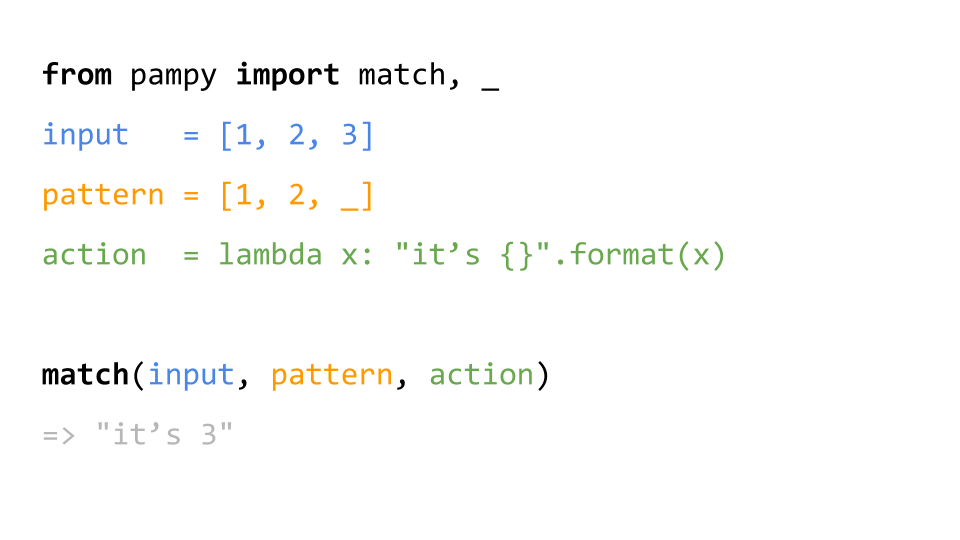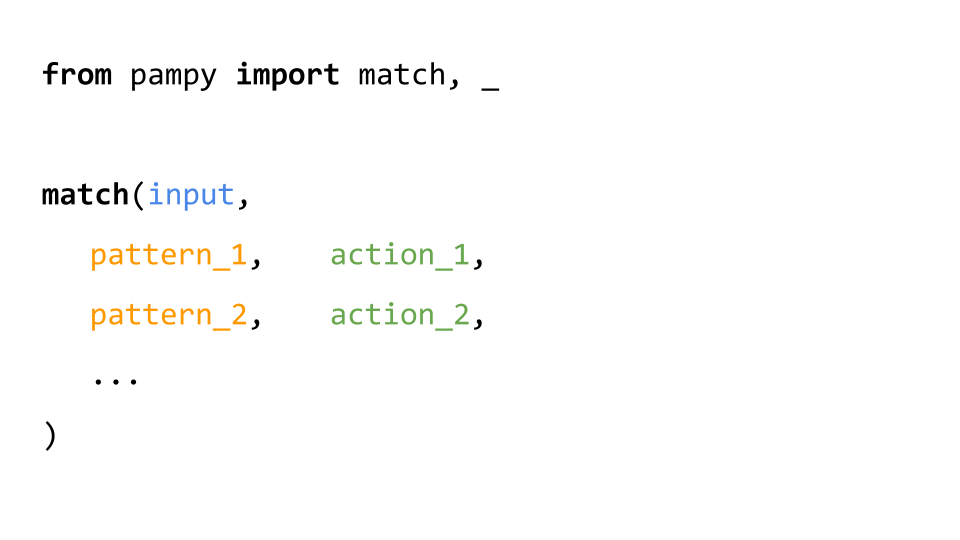The Pattern Matching for Python you always dreamed of
Project description
Pampy: Pattern Matching for Python
Pampy is pretty small (150 lines), reasonably fast, and often makes your code more readable and hence easier to reason about. There is also a JavaScript version, called Pampy.js.

You can write many patterns
Patterns are evaluated in the order they appear.

You can write Fibonacci
The operator _ means "any other case I didn't think of".
from pampy import match, _
def fibonacci(n):
return match(n,
1, 1,
2, 1,
_, lambda x: fibonacci(x-1) + fibonacci(x-2)
)
You can write a Lisp calculator in 5 lines
from pampy import match, REST, _
def lisp(exp):
return match(exp,
int, lambda x: x,
callable, lambda x: x,
(callable, REST), lambda f, rest: f(*map(lisp, rest)),
tuple, lambda t: list(map(lisp, t)),
)
plus = lambda a, b: a + b
minus = lambda a, b: a - b
from functools import reduce
lisp((plus, 1, 2)) # => 3
lisp((plus, 1, (minus, 4, 2))) # => 3
lisp((reduce, plus, (range, 10))) # => 45
You can match so many things!
match(x,
3, "this matches the number 3",
int, "matches any integer",
(str, int), lambda a, b: "a tuple (a, b) you can use in a function",
[1, 2, _], "any list of 3 elements that begins with [1, 2]",
{'x': _}, "any dict with a key 'x' and any value associated",
_, "anything else"
)
You can match [HEAD, TAIL]
from pampy import match, HEAD, TAIL, _
x = [1, 2, 3]
match(x, [1, TAIL], lambda t: t) # => [2, 3]
match(x, [HEAD, TAIL], lambda h, t: (h, t)) # => (1, [2, 3])
TAIL and REST actually mean the same thing.
You can nest lists and tuples
from pampy import match, _
x = [1, [2, 3], 4]
match(x, [1, [_, 3], _], lambda a, b: [1, [a, 3], b]) # => [1, [2, 3], 4]
You can nest dicts. And you can use _ as key!
pet = { 'type': 'dog', 'details': { 'age': 3 } }
match(pet, { 'details': { 'age': _ } }, lambda age: age) # => 3
match(pet, { _ : { 'age': _ } }, lambda a, b: (a, b)) # => ('details', 3)
It feels like putting multiple _ inside dicts shouldn't work. Isn't ordering in dicts not guaranteed ? But it does because in Python 3.7, dict maintains insertion key order by default
You can match class hierarchies
class Pet: pass
class Dog(Pet): pass
class Cat(Pet): pass
class Hamster(Pet): pass
def what_is(x):
return match(x,
Dog, 'dog',
Cat, 'cat',
Pet, 'any other pet',
_, 'this is not a pet at all',
)
what_is(Cat()) # => 'cat'
what_is(Dog()) # => 'dog'
what_is(Hamster()) # => 'any other pet'
what_is(Pet()) # => 'any other pet'
what_is(42) # => 'this is not a pet at all'
All the things you can match
As Pattern you can use any Python type, any class, or any Python value.
The operator _ and built-in types like int or str, extract variables that are passed to functions.
Types and Classes are matched via instanceof(value, pattern).
Iterable Patterns match recursively through all their elements. The same goes for dictionaries.
| Pattern Example | What it means | Matched Example | Arguments Passed to function | NOT Matched Example |
|---|---|---|---|---|
"hello" |
only the string "hello" matches |
"hello" |
nothing | any other value |
None |
only None |
None |
nothing | any other value |
int |
Any integer | 42 |
42 |
any other value |
float |
Any float number | 2.35 |
2.35 |
any other value |
str |
Any string | "hello" |
"hello" |
any other value |
tuple |
Any tuple | (1, 2) |
(1, 2) |
any other value |
list |
Any list | [1, 2] |
[1, 2] |
any other value |
MyClass |
Any instance of MyClass. And any object that extends MyClass. | MyClass() |
that instance | any other object |
_ |
Any object (even None) | that value | ||
ANY |
The same as _ |
that value | ||
(int, int) |
A tuple made of any two integers | (1, 2) |
1 and 2 |
(True, False) |
[1, 2, _] |
A list that starts with 1, 2 and ends with any value | [1, 2, 3] |
3 |
[1, 2, 3, 4] |
[1, 2, TAIL] |
A list that start with 1, 2 and ends with any sequence | [1, 2, 3, 4] |
[3, 4] |
[1, 7, 7, 7] |
{'type':'dog', age: _ } |
Any dict with type: "dog" and with an age |
{"type":"dog", "age": 3} |
3 |
{"type":"cat", "age":2} |
{'type':'dog', age: int } |
Any dict with type: "dog" and with an int age |
{"type":"dog", "age": 3} |
3 |
{"type":"dog", "age":2.3} |
re.compile('(\w+)-(\w+)-cat$') |
Any string that matches that regular expression expr | "my-fuffy-cat" |
"my" and "puffy" |
"fuffy-dog" |
Pet(name=_, age=7) |
Any Pet dataclass with age == 7 |
Pet('rover', 7) |
['rover'] |
Pet('rover', 8) |
Using strict=False
By default match() is strict. If no pattern matches, it raises a MatchError.
You can prevent it using strict=False. In this case match just returns False if nothing matches.
>>> match([1, 2], [1, 2, 3], "whatever")
MatchError: '_' not provided. This case is not handled: [1, 2]
>>> match([1, 2], [1, 2, 3], "whatever", strict=False)
False
Using Regular Expressions
Pampy supports Python's Regex. You can pass a compiled regex as pattern, and Pampy is going to run patter.search(), and then pass to the action function the result of .groups().
def what_is(pet):
return match(pet,
re.compile('(\w+)-(\w+)-cat$'), lambda name, my: 'cat '+name,
re.compile('(\w+)-(\w+)-dog$'), lambda name, my: 'dog '+name,
_, "something else"
)
what_is('fuffy-my-dog') # => 'dog fuffy'
what_is('puffy-her-dog') # => 'dog puffy'
what_is('carla-your-cat') # => 'cat carla'
what_is('roger-my-hamster') # => 'something else'
Using Dataclasses
Pampy supports Python 3.7 dataclasses. You can pass the operator _ as arguments and it will match those fields.
@dataclass
class Pet:
name: str
age: int
pet = Pet('rover', 7)
match(pet, Pet('rover', _), lambda age: age) # => 7
match(pet, Pet(_, 7), lambda name: name) # => 'rover'
match(pet, Pet(_, _), lambda name, age: (name, age)) # => ('rover', 7)
Install
Currently it works only in Python >= 3.6 Because dict matching can work only in the latest Pythons.
I'm currently working on a backport with some minor syntax changes for Python2.
To install it:
$ pip install pampy
or
$ pip3 install pampy
Project details
Release history Release notifications | RSS feed
Download files
Download the file for your platform. If you're not sure which to choose, learn more about installing packages.
Source Distributions
Built Distribution
File details
Details for the file backports.pampy-0.1.10-py2.py3-none-any.whl.
File metadata
- Download URL: backports.pampy-0.1.10-py2.py3-none-any.whl
- Upload date:
- Size: 9.7 kB
- Tags: Python 2, Python 3
- Uploaded using Trusted Publishing? No
- Uploaded via: twine/1.12.1 pkginfo/1.4.2 requests/2.21.0 setuptools/40.6.3 requests-toolbelt/0.8.0 tqdm/4.28.1 CPython/3.6.7
File hashes
| Algorithm | Hash digest | |
|---|---|---|
| SHA256 | 55e4d6f98dac6bad3fc537ee816820c87a03cd8be85cf0d617b6d17474b58da2 |
|
| MD5 | f14fe0e7ee3b84d883b7ee7d5a9c3336 |
|
| BLAKE2b-256 | 3189cf98bde4a64aa70910958019011cf77f73fa18043cb6242251f5811b2f88 |















